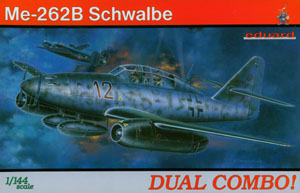Eduard 1/144 Me 262B Dual Combo
|
 |
Overview
As the first operational jet fighter, the Messerschmitt Me 262 is a
popular subject. Its history is well known, and interesting camouflage
schemes coupled with attractive lines makes it almost guaranteed to show
up on many modelers’ shelves. This can be seen by the vast number
of kits available, from the large 1/32 Hasegawa and Trumpeter kits down
to the multitude of 1/72 kits. Until now, though, 1/72 has remained the
smallest scale for plastic model kits of the Me 262. Eduard has changed
that with this latest release in their growing 1/144 kits.
The Kit(s)
 One
nice thing about coming out with a subject like this in 1/144 is that
you can include two aircraft in one box and not have to make a bigger
box. This is one small model, with each aircraft comprising two sprues
of tan plastic, one of clear, and a small photoetch fret. The decal sheet
is small but provides markings for several Me 262Bs. In fact, the painting
instructions are more pages than the actual assembly instructions. One
nice thing about coming out with a subject like this in 1/144 is that
you can include two aircraft in one box and not have to make a bigger
box. This is one small model, with each aircraft comprising two sprues
of tan plastic, one of clear, and a small photoetch fret. The decal sheet
is small but provides markings for several Me 262Bs. In fact, the painting
instructions are more pages than the actual assembly instructions.
Speaking of assembly, building these will be quite simple. Although
small in scale, you still get two cockpits with seats. No control sticks
or other details, but those are easily added from sprue scraps. Most of
the detailing done here should be done with a fine brush anyway. The nose
gear well is made up of two parts that fit into the fuselage halves. This
leaves little room for weight, which is indicated in the instructions
as necessary to keep the model on its tricycle landing gear.
 Once
the fuselage halves are together, the rest of the assembly is very simple.
The wing is one piece and meshes with the fuselage assembly. A separate
rudder and tailplanes completes the main assembly. For the engine nacelles,
these are split into right and left halves, with separate intake and exhaust
bullet fairings. Landing gear is detailed but sturdy, and features separate
retraction links. Two drop tanks and their mounts round out the plastic
pieces, while the photoetch provides the nose radar antennae and the antenna
for under the fuselage. And that’s it for assembly! Once
the fuselage halves are together, the rest of the assembly is very simple.
The wing is one piece and meshes with the fuselage assembly. A separate
rudder and tailplanes completes the main assembly. For the engine nacelles,
these are split into right and left halves, with separate intake and exhaust
bullet fairings. Landing gear is detailed but sturdy, and features separate
retraction links. Two drop tanks and their mounts round out the plastic
pieces, while the photoetch provides the nose radar antennae and the antenna
for under the fuselage. And that’s it for assembly!
 For
markings, there are a total of four schemes. That means buying two boxes
will use up all the options, which would make for a neat Me 262 collection.
The first option is Red 12, a Me 262B-1a/U1 of 10./NJG 11 at Schleswig
in May of 1945. It has a black belly and an RLM 76 upper surface mottled
with RLM 81/82. The second choice, camouflaged similarly and from the
same unit, carries a smaller Red 8 on the fuselage. Option number three
is a Me 262B-1a from JG 7 at Zatec in May of 1945. It has a standard day
fighter camouflage of RLM 82/83 over RLM 76. It has a yellow band around
the rear fuselage and has a Black A on the fuselage. The final option
is a Me 262B-1a of JV44, coded White S. It is camouflaged in RLM 81/82
over RLM 76 and has a white swastika on the tail. The decals are well
printed and include some stenciling, which will enhance the finished model. For
markings, there are a total of four schemes. That means buying two boxes
will use up all the options, which would make for a neat Me 262 collection.
The first option is Red 12, a Me 262B-1a/U1 of 10./NJG 11 at Schleswig
in May of 1945. It has a black belly and an RLM 76 upper surface mottled
with RLM 81/82. The second choice, camouflaged similarly and from the
same unit, carries a smaller Red 8 on the fuselage. Option number three
is a Me 262B-1a from JG 7 at Zatec in May of 1945. It has a standard day
fighter camouflage of RLM 82/83 over RLM 76. It has a yellow band around
the rear fuselage and has a Black A on the fuselage. The final option
is a Me 262B-1a of JV44, coded White S. It is camouflaged in RLM 81/82
over RLM 76 and has a white swastika on the tail. The decals are well
printed and include some stenciling, which will enhance the finished model.
Conclusion
This is a great subject for this small scale and will go quite well
with other 1/144 aircraft. Even if this is not your scale, the ease of
assembly will make this a great relaxing weekend build. My thanks to Eduard
for the review sample. |
|
